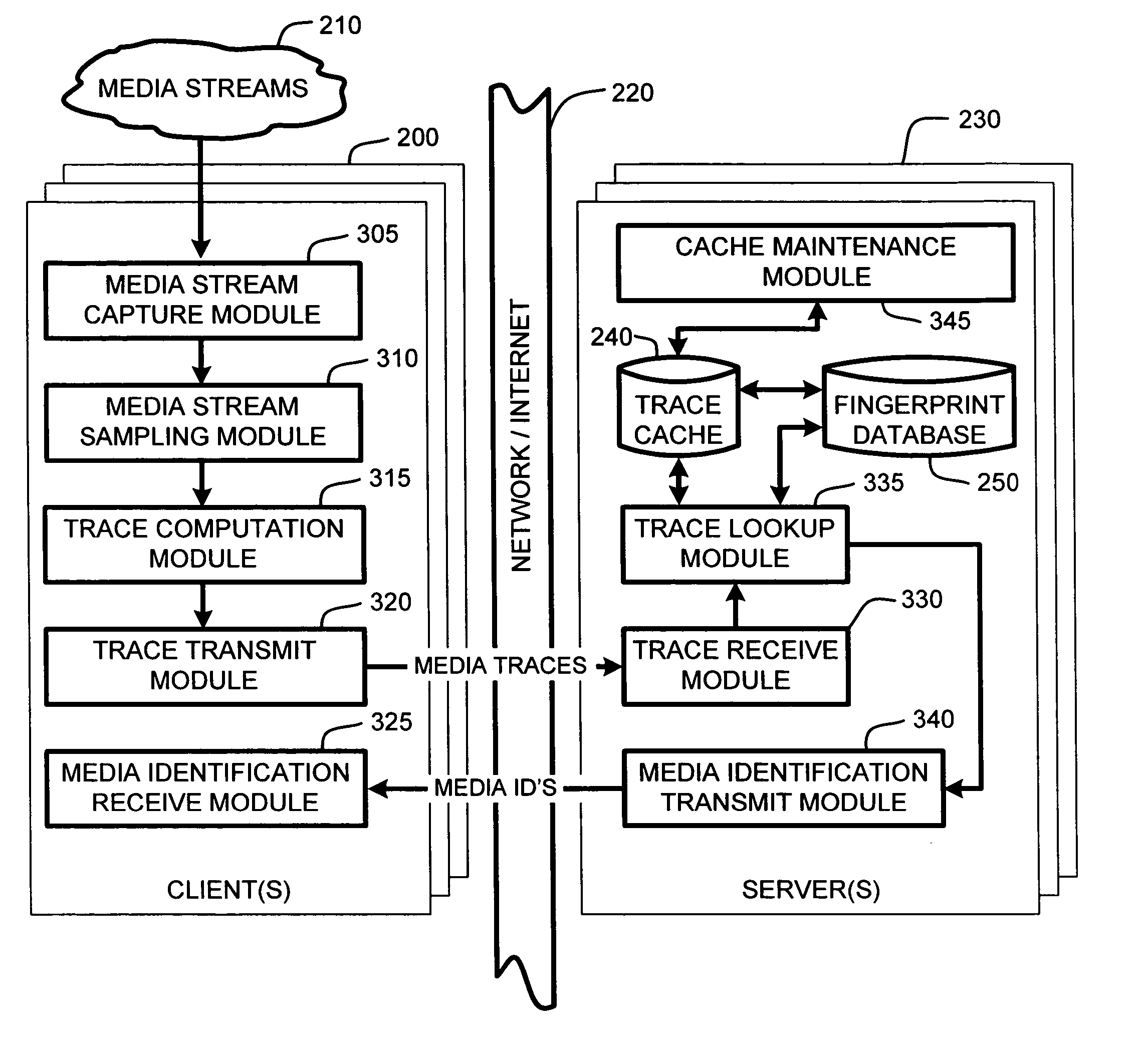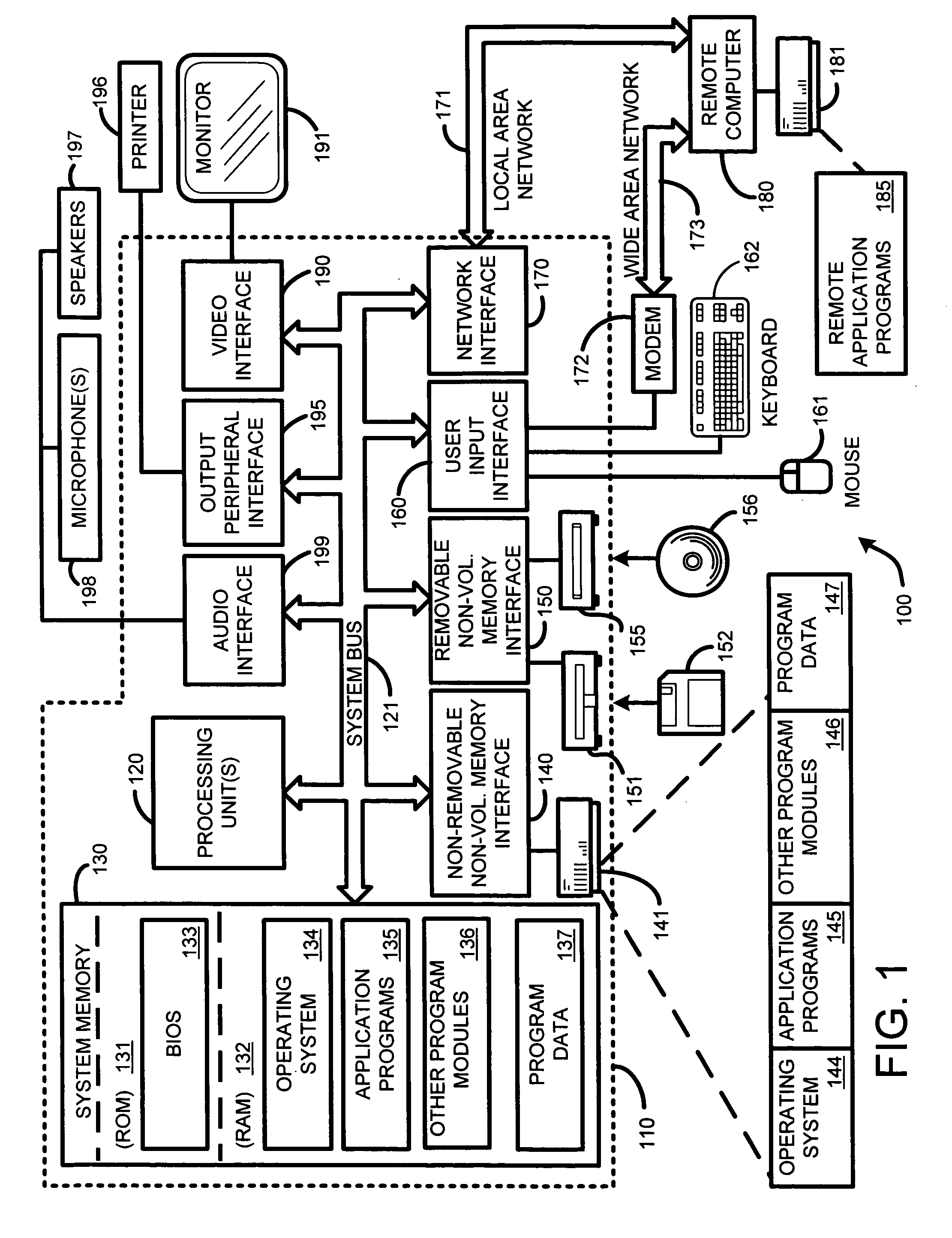[0013] The fingerprints comprising the
fingerprint database are generally computed in the same manner as the traces, using the same algorithms. However, unlike the traces, the fingerprints are only computed once, from one or more samples of each known media object so as to build the database of known fingerprints. Once created, this database is then simply accessed by the server, with no need to re-compute the fingerprints for known media objects. However, the database of known fingerprints can then be updated with new fingerprints as
new media objects (songs, etc.) are created. Therefore, the database of known fingerprints is preferably created offline and then simply provided to the server so as to eliminate any additional computational load on the server during the media identification operations performed by the Media Identifier described herein
[0014] For each
client, the server then uses inexact matching to determine whether any of the traces match any of the fingerprints in the database within some threshold or tolerance. The use of such inexact matching techniques is preferable over
exact matching techniques, since the traces computed by any of the clients can vary due to
noise, interference,
signal attenuation, etc., even where the traces are computed from the exact same portions of the media
stream. Further, the use of inexact matching also accounts for small temporal offsets of the sampled portions of the media stream from which the traces were computed. In one embodiment, the inexact matching uses
fingerprint-specific
renormalization, to improve accuracy, as is known in the art, such as described in the publication entitled “
Distortion Discriminant Analysis for Audio Fingerprinting,” by Christopher J. C. Burges, John C. Platt, and Soumya Jana, IEEE transactions on Speech and Audio
Processing, IEEE Transactions on Speech and Audio
Processing, Vol. 11, No. 3, pp 165-174, May 2003, the
subject matter of which is incorporated herein by this reference.
[0016] However, rather than providing a
brute force search of the
fingerprint database for every trace sent to the server, the Media Identifier described herein introduces an extra server-side cache which leverages the fact that at any time, many of the user-generated traces are likely to be almost identical, assuming that there are a finite number of media streams, and that there are typically a large number of users that are receiving the same media stream at any given time. In other words, at any given point in time, it is likely that there are many, potentially tens of thousands or even millions, of people that are listening to the same media stream, such as particular radio, television, or Internet broadcasts. This observation allows for the creation of the server-side cache which caches both the incoming traces and the results of the database search for matching fingerprints.
[0019] In general, the bit vector indexing methods described in the aforementioned U.S.
Patent Application and the corresponding Microsoft Technical Report addresses the problem of quickly performing point queries against high-dimensional regions. Such queries are useful in the increasingly important problems of
multimedia identification and retrieval, where different database entries have different
metrics for similarity. In contrast to typical database indexing which focuses on indexing for high-dimensional nearest neighbor and epsilon range queries, indexing for point queries against high-dimensional regions provides an efficient indexing method which relies on the combination of redundancy and bit vector indexing to achieve significant performance gains. Such methods have been observed to provide a significant performance increase over real-world linear scans.
[0021] One
advantage of the server-side cache provided by the Media Identifier is that the size of the cache is relatively small, making cache searches extremely rapid. In particular, the cache size is a function of the maximum expected
delay between clients of receiving a point in the media stream, and the number of unique media streams for which identification services are being provided. Further, it should be noted that the cache size is not a function of the number of users.
[0023] Therefore, there is no need to keep traces in the media cache for longer than some small multiple of the maximum expected
delay time (with the
delay time also including the maximum expected delay for each
client to compute and transmit the trace to the server). In other words, this delay is simply the maximum time between the server receiving the first trace for a given section of a particular media object, and the server receiving the last trace (from the slowest client) for the section of the same media object. Consequently, traces need only be kept for a short period, on the order of several seconds. As a result, there is no need for a large cache to store all of the unique incoming traces.
 Login to View More
Login to View More  Login to View More
Login to View More 


